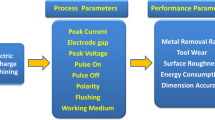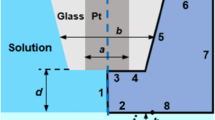Abstract
Microstructures are applied in various fields to improve the friction and lubrication of mechanical components. Through-mask electrochemical etching (TMEE) has shown good feasibility in machining microstructure array. However, the machining precision of microstructures gradually decreases with increasing etching depth in TMEE. Localization and uniformity are essential indicators of machining precision in TMEE. This study proposed the particle assisted through-mask electrochemical etching (PA-TMEE) method to increase localization and uniformity. Firstly, a coupled multi-physical field model, including gas–liquid two-phase flow, particle motion, and electrochemical processes, was established and adopted to predict the profiles of micro pits. Secondly, the comparison experimental results show that using PA-TMEE instead of TMEE resulted in improved localization and uniformity of the micro pit array. Then, the paper analyzed the effect of particle diameter and content on micro pits. When the particle diameter was 40 μm and the particle content was 6 g/L, the maximum etching depth was 58 μm. The etching factor was 2.4. The minimum coefficient of variation of the diameter and depth of micro pits was 3.3% and 5.2%, respectively. Finally, based on scanning electron microscopy and energy-dispersive spectrometer analysis, the machining mechanism of the PA-TMEE method is composed of particle erosion and electrochemical etching.


















Similar content being viewed by others
Availability of data and material
Yes, the data and material are available.
Code availability
Not applicable.
References
Gachot C, Rosenkranz A, Hsu SM, Costa HL (2017) A critical assessment of surface texturing for friction and wear improvement. Wear 372–373:21–41. https://doi.org/10.1016/j.wear.2016.11.020
Cho M (2016) Friction and wear of a hybrid surface texturing of polyphenylene sulfide-filled micropores. Wear 346–347:158–167. https://doi.org/10.1016/j.wear.2015.11.010
Qu J, Xu HB, Feng ZL, Frederick DA, An LA, Heinrich H (2011) Improving the tribological characteristics of aluminum 6061 alloy by surface compositing with sub-micro-size ceramic particles via friction stir processing. Wear 271:1940–1945. https://doi.org/10.1016/j.wear.2010.11.046
Li DX, Chen XX, Guo CH, Tao J, Tian CX, Deng YM, Zhang WW (2017) Micro surface texturing of alumina ceramic with nanosecond laser. Procedia Engineer 174:370–376. https://doi.org/10.1016/j.proeng.2017.01.155
Wu X, Li L, He N, Zhao GL, Shen JY (2019) Investigation on the surface formation mechanism in micro milling of cemented carbide. Int J Refract Metal Hard Mater 78:61–67. https://doi.org/10.1016/j.ijrmhm.2018.09.001
Wang H, Chi GX, Wang YK, Yu FX, Wang ZL (2019) Fabrication of superhydrophobic metallic surface on the electrical discharge machining basement. Appl Surf Sci 478:110–118. https://doi.org/10.1016/j.apsusc.2019.01.102
Zhai K, Du L, Wen Y, Wang S, Cao Q, Zhang X, Liu J (2020) Fabrication of micro pits based on megasonic assisted through-mask electrochemical micromachining. Ultrasonics 100:105990. https://doi.org/10.1016/j.ultras.2019.105990
Chen XL, Qu NS, Li HS, Xu ZY (2015) Pulsed electrochemical micromachining for generating micro-dimple arrays on a cylindrical surface with a flexible mask. Appl Surf Sci 343:141–147. https://doi.org/10.1016/j.apsusc.2015.03.087
Saxena KK, Qian J, Reynaerts D (2018) A review on process capabilities of electrochemical micromachining and its hybrid variants. Int J Mach Tool Manu 127:28–56. https://doi.org/10.1016/j.ijmachtools.2018.01.004
Landolt D, Chauvy PF, Zinger O (2003) Electrochemical micromachining, polishing and surface structuring of metals: fundamental aspects and new developments. Electrochim Acta 48:3185–3201. https://doi.org/10.1016/S0013-4686(03)00368-2
Qian SQ, Ji F, Qu NS, Li HS (2014) Improving the localization of surface texture by electrochemical machining with auxiliary anode. Mater Manuf Processes 29:1488–1493. https://doi.org/10.1080/10426914.2014.930950
Chen XL, Qu NS, Li HS (2015) Improvement of dimensional uniformity on micro-dimple arrays generated by electrochemical micro-machining with an auxiliary electrode. Int J Adv Manuf Tech 80:1577–1585. https://doi.org/10.1007/s00170-015-7147-6
Zhang XF, Qu NS, Chen XL (2016) Sandwich-like electrochemical micromachining of micro-dimples. Surf Coat Tech 302:438–447. https://doi.org/10.1016/j.surfcoat.2016.05.088
Zhang XF, Qu NS, Fang XL (2017) Sandwich-like electrochemical micromachining of micro-dimples using a porous metal cathode. Surf Coat Tech 311:357–364. https://doi.org/10.1016/j.surfcoat.2017.01.035
Pan YQ, Hou ZB, Qu NS (2019) Improvement in accuracy of micro-dimple arrays prepared by micro-electrochemical machining with high-pressure hydrostatic electrolyte. Int J Adv Manuf Tech 100:1767–1777. https://doi.org/10.1007/s00170-018-2822-z
Kim Y, Youn S, Cho YH, Park H, Chang BG, Oh YS (2011) A multi-step electrochemical etching process for a three-dimensional micro probe array. J Micromech Microeng 21(1):015019. https://doi.org/10.1088/0960-1317/21/1/015019
Mineta T (2004) Electrochemical etching of a shape memory alloy using new electrolyte solutions. J Micromech Microeng 14:76–80. https://doi.org/10.1088/0960-1317/14/1/310
Chauvy PF, Hoffmann P, Landolt D (2003) Applications of laser lithography on oxide film to titanium micromachining. Appl Surf Sci 208:165–170. https://doi.org/10.1016/S0169-4332(02)01361-2
Baldhoff T, Nock V, Marshall AT (2018) Review-through-mask electrochemical micromachining. J Electrochem Soc 165:E841–E855. https://doi.org/10.1149/2.1341814jes
Qu NS, Chen XL, Li HS, Zeng YB (2014) Electrochemical micromachining of micro-dimple arrays on cylindrical inner surfaces using a dry-film photoresist. Chinese J Aeronaut 27:1030–1036. https://doi.org/10.1016/j.cja.2014.03.012
Ming PM, Zhao CH, Zhang XM, Li XC, Qin G, Yan L (2018) Investigation of foamed cathode through-mask electrochemical micromachining developed for uniform texturing on metallic cylindrical surface. Int J Adv Manuf Tech 96:3043–3056. https://doi.org/10.1007/s00170-018-1755-x
Jain VK, Chouksey AK (2018) A comprehensive analysis of three-phase electrolyte conductivity during electrochemical macromachining/micromachining. P I Mech Eng B-J Eng 232:2449–2461. https://doi.org/10.1177/0954405417690558
Schultze JW, Lohrengel MM (2000) Stability, reactivity and breakdown of passive films. Problems of recent and future research. Electrochim Acta 45:2499–2513. https://doi.org/10.1016/S0013-4686(00)00347-9
Finnie I (1995) Some reflections on the past and future of erosion. Wear 186:1–10. https://doi.org/10.1016/0043-1648(95)07188-1
Wang JY, Xu JW (2001) Principle and application of electrochemical machining. China Machine Press (In Chinese)
Fang XL, Qu NS, Zhang YD, Xu ZY, Zhu D (2014) Effects of pulsating electrolyte flow in electrochemical machining. J Mater Process Tech 214:36–43. https://doi.org/10.1016/j.jmatprotec.2013.07.012
Sharma MK, Suru A, Joshi A, Kulkarni AA (2020) A novel flow reactor for handling suspensions: hydrodynamics and performance evaluation. Ind Eng Chem Res 59:16462–16472. https://doi.org/10.1021/acs.iecr.9b06864
Funding
This work was supported by the National Natural Science Foundation of China (No. 51975103) and Dalian Science & Technology Innovation Fund (2020JJ25CY018).
Author information
Authors and Affiliations
Contributions
Liqun Du: Conceptualization, methodology, data curation, and funding acquisition. Mingxin Yu: Investigation, validation, writing—original draft, and writing—review and editing. Ke Zhai: Writing—review and editing. Kunming Zheng: Supervision. Haohao Cheng: Supervision and formal analysis. Shuxuan Wang: Supervision and writing—review and editing. Junshan Liu: Supervision.
Corresponding authors
Ethics declarations
Ethics approval
Not applicable.
Consent to participate
Not applicable.
Consent for publication
Not applicable.
Competing interests
The authors declare no competing interests.
Additional information
Publisher's Note
Springer Nature remains neutral with regard to jurisdictional claims in published maps and institutional affiliations.
Rights and permissions
Springer Nature or its licensor holds exclusive rights to this article under a publishing agreement with the author(s) or other rightsholder(s); author self-archiving of the accepted manuscript version of this article is solely governed by the terms of such publishing agreement and applicable law.
About this article
Cite this article
Du, L., Yu, M., Zhai, K. et al. Investigation on particle assisted through-mask electrochemical etching of micro pit array. Int J Adv Manuf Technol 123, 465–478 (2022). https://doi.org/10.1007/s00170-022-10181-8
Received:
Accepted:
Published:
Issue Date:
DOI: https://doi.org/10.1007/s00170-022-10181-8




